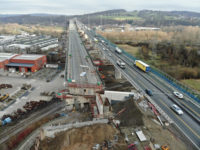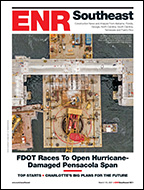 |
| Ribbon Bridge. Military bridge can be assembled quickly to replace crucial crossing. |
Operation Bridge Out, coordinated by the U.S. Coast Guard, let 70 American and Canadian agencies test their ability to respond to a real emergency involving destroyed infrastructure. In the scenario, terrorists hijack a loaded fuel tanker truck, drive to the center span of the bridge and set off an explosion. The blast causes a span to warp and collapse.
Designed by Germanys General Dynamics Santa Barbara Sistemas Gmbh for the U.S. Army, improved ribbon bridges are a new version of traditional ribbon-bridge rafts. Each has a 96-ton load capacity. Terrain, river speed and channel width helped determine the crossing site, says Maj. Edward Hallenbeck, of the Lansing-based National Guards Joint Forces Headquarters.
The modular aluminum-alloy continuous floating bridge system consists of interior and ramp bays that are transported, launched and retrieved by vehicles called common bridge transporters (CBT). CBTs are equipped with rear-mounted hydraulic booms working with an 11,000-lb-capacity winch. Carried in a folded W position, the bays automatically open on entering water due to buoyant forces that actuate a cable and lever system to form a 22-ft-long bridge section.
Members of the 1437th ferried or boated to Sugar Island, while others launched partially assembled bridge sections from Michigan and rafted them 91Ú2 miles to the rivers narrowest point, where the bridge was to be built. "In a real emergency scenario wed obviously get a lot closer [to the site]," Hallenbeck says. "In combat conditions and without the long rafting distance, this type of bridge can be constructed at a rate of 200 meters per hour."
Soldiers on the bays and in boats hooked the bays together. Two CBTs rafted to the Ontario side, where existing docks were temporarily removed. Steel cables connected the CBTs to the bridge at 45° angles, while some anchors were placed against the bridges downstream side to hold it in place, says Hallenbeck.
The participating agencies will hold a debriefing exercise in a few weeks to review what was learned, says Cpl. Mike Duguay, of the Royal Canadian Mounted Police in Sault Ste. Marie, Ontario.
f a May 10 mock-terrorist attack drill is any indicator, a substitute crossing can be erected in five hours should the U.S.-Canadian International Bridge ever be shut down. The Michigan National Guards 1437th Multi-Role Bridge Co. rushed to the site of the bridge linking Sault Ste. Marie, Mich., with its Ontario counterpart and erected a 780-ft-long ribbon bridge from Sugar Island in Michigans Upper Peninsula across St. Marys River in five hours.


Post a comment to this article
Report Abusive Comment